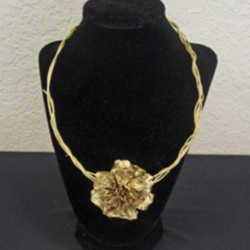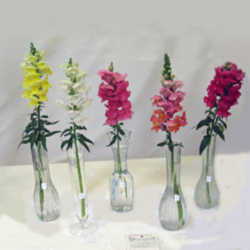Let me say from the beginning that learning about Standard Flower Shows can engross a person for a lifetime. NGC sponsors a school to teach members and judges about flower shows. Aptly called Flower Show School and conducted throughout the United States and affiliate countries, these schools are listed on NGC's website.
The 356 page Handbook for Flower Shows, sometimes termed the "flower show bible" outlines the requirements for shows given by NGC member clubs. It is the textbook for Flower Show School. We study it, teach it, and think we have grasped the information within it; but often we fall short of absolute accuracy. It's all very complicated, but we do the best we can to conform to the standards set forth by NGC.
 So what are some of the standards to which a show must conform in order to be a Standard Flower Show? First of all, the show must be planned and staged by an NGC member club or group of clubs. Fresh plant material must be emphasized throughout the show. The Schedule must be written and mechanically reproduced with specific wording that includes all essential details of the show. The show must include a Horticulture Division and a Design Division. It must be judged by a panel or panels of NGC approved judges, and it must be judged by the NGC Standard System of Awarding.
So what are some of the standards to which a show must conform in order to be a Standard Flower Show? First of all, the show must be planned and staged by an NGC member club or group of clubs. Fresh plant material must be emphasized throughout the show. The Schedule must be written and mechanically reproduced with specific wording that includes all essential details of the show. The show must include a Horticulture Division and a Design Division. It must be judged by a panel or panels of NGC approved judges, and it must be judged by the NGC Standard System of Awarding.
 Each division is composed of sections. Each section is made up of related classes. Each class consists of individual exhibits. Generally speaking, a show must have as many (or more) classes and exhibits of horticulture as design.
Each division is composed of sections. Each section is made up of related classes. Each class consists of individual exhibits. Generally speaking, a show must have as many (or more) classes and exhibits of horticulture as design.
The Schedule, which is the law of the show, is generally written by a club member or committee. It must be accepted by the club, and all exhibitors and judges are bound by its requirements. My club's schedule for this year's flower show is an eleven-page document. The schedule writer must have a good basic knowledge of the Handbook for Flower Shows, for it is always the ultimate authority. The Schedule is duplicated, and club members, participants, and judges are given a copy. An abbreviated copy may be made for the viewing public.
The smallest possible show is the Small Standard Flower Show. There are three other categories of Standard Flower Shows as determined by size. Any size show may also include a Special Exhibits Division. In this division are such things as youth exhibits, educational exhibits, sponsored groups, and gardens. Also allowed, but not eligible for top exhibitor awards are invitational exhibits, commercial exhibits, artistic crafts, and even a plant exchange or sale.
 All this may seem like an awful lot of information. It is, of course. Those of us who deal with Standard Flower Shows grow to love the challenge and constantly strive for excellence. Each flower show presents new problems to be solved, new plants and flowers to learn, and new designs to create. Every show is unique and different, and participating in them is an exciting adventure.
All this may seem like an awful lot of information. It is, of course. Those of us who deal with Standard Flower Shows grow to love the challenge and constantly strive for excellence. Each flower show presents new problems to be solved, new plants and flowers to learn, and new designs to create. Every show is unique and different, and participating in them is an exciting adventure.
The pay-off comes at judging time. Will your design win a blue ribbon? Will your horticulture exhibit be considered for a top award? While these are considerations that haunt every exhibitor, the most important questions to ask are, "Did I learn something?" and "Did I have fun?" If exhibitors can answer "yes" to one or both of these questions, their time was well spent.
| Categories of NGC Standard Flower Shows Small Standard Flower Show Horticulture Division: Twenty or more exhibits entered in a minimum of five classes which are listed in the schedule Design Division: Twelve to nineteen exhibits entered in a minimum of three classes listed in the schedule, with at least four exhibits in each class Standard Flower Show Design Division: Twenty or more design exhibits entered with a minimum of five classes listed in the schedule, with four exhibits or more in each class. Horticulture Division: Twenty or more horticulture exhibits entered with a minimum of five classes listed in the schedule. Advanced-Standard Flower Show: A large show that has many sections and classes well beyond the minimum requirements of a Standard Flower Show. Numerous top awards are offered. Major Flower Show: a very large flower show usually sponsored jointly with a botanical garden, plant society, or other national and international gardening or civic organization
|
| Standard System of Awarding Only one first place (blue) ribbon per class or subclass; must score 90 or above. Only one second place (red) ribbon per class or subclass; must score 85 or above. Only one third place (yellow) ribbon per class or sub-class; must score 80 or above. One or more honorable mention (white) ribbons as merited; must score 75 or above |
















